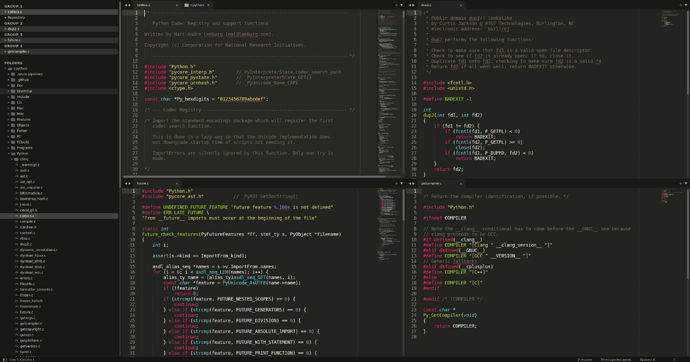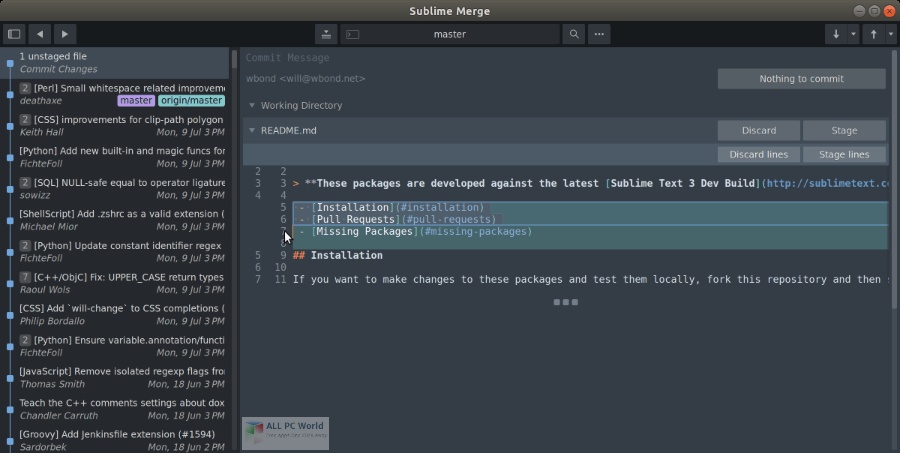
- Sublime merge key install#
- Sublime merge key generator#
- Sublime merge key verification#
- Sublime merge key code#
- Sublime merge key free#
Simple, and integrates well into my existing Sublime Text workflow. ThereĪre a ton of different ones out there but I’ve found that Sublime Merge is fast, Git client makes things like adding hunks or fixing conflicts a breeze. I prefer to use Git with a dedicated client. We can alleviateĪny concerns of identity as now all of our commits are signed and verified. Signing of commits works on the command line beautifully now. Enabling Signing of commits in Sublime Merge or other Git clients Gpg: Signature made Wed 09:30:37 AM EDT using RSA key ID 3AA5C34371567BD2Īnd if you push a newly signed commit to Github you can see your verified identity Once you start signing commits you can see the signatures appear next to yourĬommit headers in the log using -show-signature. That being said I’m not too worried about something like this as I’m using several other security Then a saved passphrase means it isn’t really you. This is a bit more secure if you consider the scenario of someone having access to your physical computer On the flip-side, there’s something to be said about always entering the passphrase for every commit. Let me know if this isn’t theĬase for operating system or if you have a different solution. I really like how simple this makes the signing process. My prompt allowed me to remember my passphrase which means I no longer need to enter it. One to use by following the Generating a new GPG key section of If you have an existing key you’ll need to enter yourĬan’t remember it? You can always create a new
Sublime merge key verification#
We did this above after the identity verification step Now the first time you go to sign a commit it will prompt you with entering a These must be used in tandem in order to gather proper output. Additionally, the -exportįlag simply exports the key that we specify. Without this we won’tīe able to copy our key and paste it into Github. Using the key id, we’ll gather the GPG key signature by using the -armor flag which is In our case that means using 3AA5C34371567BD2 from above. To operate in ASCII mode, use the -armor (or -a) switch.įirst, grab the key id which can be found on the sec line after the keysize specification On the other hand, when sending a file, you can (and should, it will make the encrypted file smaller) use the default non-ASCII mode. When sending something that will be viewed as text (i.e. Since PGP can operate both in ASCII mode and “raw” mode, it’s important to understand when to use which one. Now, we need to export our GPG key to be used on Github via the command: gpg -armor -export ASCII vs Raw mode Gpg -list-secret-keys -keyid-format LONG will list out all your existing keys that have a public and private Now we need to grab our generated GPG key and add it to our Github account.

That’s it we’ve created our first GPG key. Gpg: 3 marginal (s ) needed, 1 complete (s ) needed, PGP trust model Public and secret key created and signed. Gpg: key 3AA5C34371567BD2 marked as ultimately trusted
Sublime merge key generator#
Generator a better chance to gain enough entropy. Some other action ( type on the keyboard, move the mouse, utilize theĭisks ) during the prime generation this gives the random number We need to generate a lot of random bytes. Unfortunately, the command it recommends for gpg as well as gpg2 doesn’t actually work. Github has some great documentation on generating gpg keys.
Sublime merge key install#
If it doesn’t then you need to install it with sudo apt-get install gpg for linux or brew install gnupg for homebrew on MacOS. You can check this by running which gpg which should return GnuPG allows you to encrypt and sign your data and communications it features a versatile key management system, along with access modules for all kinds of public key directories. Making sure GPG is installed GPG (GNU Privacy Guard) Updated this tutorial for both Linux Debian and MacOSX. It should work relatively the same for MacOS (not sure about Windows). I’m also writing this tutorial from the perspective of a Linux distribution but Private/public key pair, go ahead and skip down to the step, Finding your GPG key”. Gpg -list-secret-keys -keyid-format LONG. You do (or aren’t sure) you can run the command:
Sublime merge key code#
Not only is this a great way to see at a glance if code comesįrom a trusted source, but the verified badge looks slick.įor the remainder of this tutorial, I’m assuming you don’t have a generated GPG key. Github has taken this one step farther and now shows signed commit authors withĪ verified badge.


Sublime merge key free#
This is accomplished by using GPG which is a free encryption and signing tool. Signing your commit you’re saying that it originated from a verified author. This is especially important if you are an open source contributor. Signing commits is a great way to add additional level of confidence to your code.


 0 kommentar(er)
0 kommentar(er)
